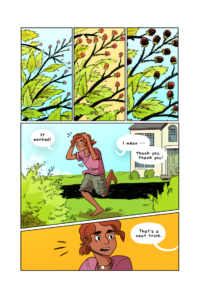
Happy Halloween! Molly Ostertag’s The Witch Boy is in stores today, which means you can get your hands on a copy of this awesome graphic novel. I had the opportunity to chat about the book with Ostertag via e-mail. She also talked about the magic in the book’s universe, why she wrote a middle grade graphic novel, and her Halloween traditions. Readon!
 Rogues Portal: Where did the inspiration for The Witch Boy come from initially and how did the story grow as you wrote the book?
Rogues Portal: Where did the inspiration for The Witch Boy come from initially and how did the story grow as you wrote the book?
Molly Ostertag: Gender fluidity is a trope in YA books, but often it only goes one way – stories about girls dressing as boys, or taking up typically male roles, in order to go on the adventure of the book. I loved those stories when I was young, and found a lot of strength in them, but I wanted to make something that went the other way. That was the germ of the idea, but as I started playing around with ideas I came to really love the characters of Aster and Charlie. The book changed a lot from the first draft to the final art, but it really found its way once those two kids and their friendship started to feel real to me.
RP: I couldn’t help but read this book as a coming out allegory — did you write it that way intentionally, or am I just reading too far into things?
MO: I’m a gay woman, and I was working on this book as I was coming out, so there are definitely those feelings in there. However, I’d argue against it being a coming out story, simply because Aster is very honest about who he is and what he wants to do. Although his family doesn’t want to hear it, and their rejection forces him to be sneaky about learning witchcraft, he’s always clear that he’s a witch. He’s a brave kid!
There are definitely LGBTQ themes in the book, and I’m very happy to have it interpreted in a number of ways. I wanted to make a book about the feeling of being young and queer, of knowing certain things about yourself and having other things be mysteries, and about the disconnect between how you want to be and how people treat you. I’m looking forward to exploring these themes more in future books.

RP: What reactions have you gotten from early readers? Have any of them surprised you?
MO: I’ve gotten positive reactions so far. It’s honestly a very strange experience to hear people talk about the book! I have ideas about what it’s about, as well as ideas about my strengths and weaknesses as a writer, but those ideas always change once they’re reflected back to me by a reader. In general people seem to be taking away what I intended, and that’s really cool.
RP: What would be your dream for this book’s reception amongst its target audience?
MO: I’d really like to reach kids who need a book that makes them feel okay for being different, for being in-between, and for not fitting into assigned roles. If I could make it easier for a few young people to feel comfortable in their own skin, and if I could make it easier for their parents and friends to understand how best to be kind to them, that would be rad.
RP: Why did you opt to write a graphic novel for kids, rather than an older age group?
MO: All of my most exciting reading experiences are from childhood. I still read a lot, and love books, but the ones that shaped me were by and large read before the age of 21. I remember accepting stories completely, losing myself in the world, and having parts of my personality and belief system by shaped by books. I wanted to make a positive book that would speak to kids and make a difference in some of their lives. I also wanted to make a book about the experience of childhood, of seeing adolescence coming but not being there yet, of just starting to discover who you are and how you are different from others, because that’s a powerful time that I remember well.

RP: Why witchery and shapeshifting? What made you associate the men in Aster’s family with the latter and the women with the former?
MO: Is it disappointing if I don’t have a very interesting reason behind this? I looked at traditions of magic all around the world and looked for commonalities, types of powers that feature in many myths and folklore. Shapeshifting, magic words, demons, protection amulets, potions – these are strong archetypes I wanted to play with. I knew I wanted Aster to be a witch, and that witchery – in many traditions and in my narrative – was considered a feminine power, so I let the men of his family have a power that connected them to nature and put them more in touch with outside forces of spirits and demons. I love werewolves and shapeshifters in fiction so I knew I wanted to explore that a bit.
RP: If Aster could shapeshift, what form do you think he would take?
MO: Well, the point is that he can’t… but I think some of his mannerisms call to mind a small bird, a sparrow or a chickadee.
RP: On a similar note, what form would you take?
MO: An otter! I’d like to play in the water and do that very cute otter thing where they float and hold hands with each other.

RP: Releasing The Witch Boy on Halloween obviously makes sense — do Aster’s family celebrate Halloween or Samhain? Do they have any traditions, if so?
MO: I’m from upstate New York, where there’s a larger than normal Wiccan/pagan presence. A lot of my thoughts around magic and gender roles in magical tradition came from having friends in this community. I reserve the right to explore this more in future books, but I know that Aster’s family celebrates the equinoxes and solstices, which are also days of power and magical ritual. They celebrate birthdays too – and there are a lot of kids in that house, so that’s plenty of cake and presents.
RP: What about you? Do you have any Halloween traditions?
MO: My birthday is three days before, so there’s always an overlap. In Los Angeles, it’s usually 90 degrees in October, so you have to be very intentional about celebrating Halloween. For the last two years, my girlfriend and I have hosted a big birthday/Halloween party in our house and go all out with the decorations and themed drinks and food. This year’s theme is witches! I work at Disney Television Animation, and we always decorate our lounge area to look like a spooky scene from our show so all the kids of employees can come trick-or-treating and it’s very fun.
RP: Can you tell me some of your favorite witches or magical beings in pop culture?
MO: I love Howl from Howl’s Moving Castle, Professor McGonagall and Hermione from Harry Potter, Nita and Kit from So You Want to Be a Wizard, Christopher Chant from The Chronicles of Chrestomanci, Daine Sarrasri from Wild Magic, and Akko, Diana, and Amanda from Little Witch Academia. Plenty of shapeshifter in there, as well!

RP: Do you plan to write more magical graphic novels in the future? Will there ever be a sequel or prequel to Aster’s story?
MO: Yes! There is actually a sequel coming out in fall 2018, which I’ve just finished drawing. It’s called THE HIDDEN WITCH, and will explore more of Charlie’s world, Aster’s study of witchery, and a mysterious curse (cue spooky music). I think all my graphic novels will have magic in them in one way or another. I just love it as a way to explore ideas and feelings, and as a subject to draw.
RP: Fox Animation has preemptively picked up the film rights to The Witch Boy — if you were in charge of casting, who would voice these characters?
MO: I’m terrible at casting, but I know that I’d really like to have actual children voice Aster and Charlie. That makes a big different to me in a film. Mikasi could be someone with a smooth, sinister voice. Tim Curry? He’s good at cartoon villains.
RP: Is there anything else you’d like to add?
MO: I’m just very excited for this book to be out! It’s a personal story to me, and I hope readers will love the characters as much as I do.
Pick up a copy of The Witch Boy online or wherever books are sold. To keep up with Molly Ostertag, follow her on Twitter. You can also check out her other work at her website, or follow her ongoing webcomic, Strong Female Protagonist.



![[REVIEW] FURY #1](https://geekd-out.com/wp-content/uploads/2023/05/fury-1-feat-150x150.jpg)